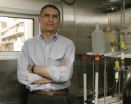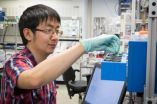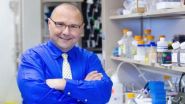(Press-News.org) CHAPEL HILL, NC – Researchers at the UNC School of Medicine have discovered how two genes – Period and Cryptochrome – keep the circadian clocks in all human cells in time and in proper rhythm with the 24-hour day, as well as the seasons. The finding, published today in the journal Genes and Development, has implications for the development of drugs for various diseases such as cancers and diabetes, as well as conditions such as metabolic syndrome, insomnia, seasonal affective disorder, obesity, and even jetlag.
"Discovering how these circadian clock genes interact has been a long-time coming," said Aziz Sancar, MD, PhD, Sarah Graham Kenan Professor of Biochemistry and Biophysics and senior author of the Genes and Development paper. "We've known for a while that four proteins were involved in generating daily rhythmicity but not exactly what they did. Now we know how the clock is reset in all cells. So we have a better idea of what to expect if we target these proteins with therapeutics."
In all human cells, there are four genes – Cryptochrome, Period, CLOCK, and BMAL1 – that work in unison to control the cyclical changes in human physiology, such as blood pressure, body temperature, and rest-sleep cycles. The way in which these genes control physiology helps prepare us for the day. This is called the circadian clock. It keeps us in proper physiological rhythm. When we try to fast-forward or rewind the natural 24-hour day, such as when we fly seven time zones away, our circadian clocks don't let us off easy; the genes and proteins need time to adjust. Jetlag is the feeling of our cells "realigning" to their new environment and the new starting point of a solar day.
Previously, scientists found that CLOCK and BMAL1 work in tandem to kick start the circadian clock. These genes bind to many other genes and turn them on to express proteins. This allows cells, such as brain cells, to behave the way we need them to at the start of a day.
Specifically, CLOCK and BMAL1 bind to a pair of genes called Period and Cryptochrome and turn them on to express proteins, which – after several modifications – wind up suppressing CLOCK and BMAL1 activity. Then, the Period and Cryptochrome proteins are degraded, allowing for the circadian clock to begin again.
"It's a feedback loop," said Sancar, who discovered Cryptochrome in 1998. "The inhibition takes 24 hours. This is why we can see gene activity go up and then down throughout the day."
But scientists didn't know exactly how that gene suppression and protein degradation happened at the back end. In fact, during experiments using one compound to stifle Cryptochrome and another drug to hinder Period, other researchers found inconsistent effects on the circadian clock, suggesting that Cryptochrome and Period did not have the same role. Sancar, a member of the UNC Lineberger Comprehensive Cancer Center who studies DNA repair in addition to the circadian clock, thought the two genes might have complementary roles. His team conducted experiments to find out.
Chris Selby, PhD, a research instructor in Sancar's lab, used two different kinds of genetics techniques to create the first-ever cell line that lacked both Cryptochrome and Period. (Each cell has two versions of each gene. Selby knocked out all four copies.)
Then Rui Ye, PhD, a postdoctoral fellow in Sancar's lab and first author of the Genes and Development paper, put Period back into the new mutant cells. But Period by itself did not inhibit CLOCK-BMAL1; it actually had no active function inside the cells.
Next, Ye put Cryptochrome alone back into the cell line. He found that Cryptochrome not only suppressed CLOCK and BMAL1, but it squashed them indefinitely.
"The Cryptochrome just sat there," Sancar said. "It wasn't degraded. The circadian clock couldn't restart."
For the final experiment, Sancar's team added Period to the cells with Cryptochrome. As Period's protein accumulated inside cells, the scientists could see that it began to remove the Cryptochrome, as well as CLOCK and BMAL1. This led to the eventual degradation of Cryptochrome, and then the CLOCK-BMAL1 genes were free to restart the circadian clock anew to complete the 24-hour cycle.
"What we've done is show how the entire clock really works," Sancar said. "Now, when we screen for drugs that target these proteins, we know to expect different outcomes and why we get those outcomes. Whether it's for treatment of jetlag or seasonal affective disorder or for controlling and optimizing cancer treatments, we had to know exactly how this clock worked."
Previous to this research, in 2010, Sancar's lab found that the level of an enzyme called XPA increased and decreased in synchrony with the circadian clock's natural oscillations throughout the day. Sancar's team proposed that chemotherapy would be most effective when XPA is at its lowest level. For humans, that's late in the afternoon.
"This means that DNA repair is controlled by the circadian clock," Sancar said. "It also means that the circadian clocks in cancer cells could become targets for cancer drugs in order to make other therapeutics more effective."
INFORMATION:
This research was funded by the National Institutes of Health and the Science Research Council and Academia Sinica in Taiwan.
Other authors of the Genes and Development paper are UNC postdoctoral fellows Yi-Ying Chiou, PhD, and Shobban Gaddameedhi, PhD, and UNC graduate student Irem Ozkan-Dagliyan.
UNC researchers find final pieces to the circadian clock puzzle
Sixteen years after scientists found the genes that control the circadian clock in all cells, the lab of UNC's Aziz Sancar, M.D., Ph.D., discovered the mechanisms responsible for keeping the clock in synch
2014-09-15
ELSE PRESS RELEASES FROM THIS DATE:
Cheaper alternative to licensed drug for treating eye disease has similar side-effects
2014-09-15
Health policies which favour using ranibizumab for treating eye disease in older people over safety concerns for a cheaper alternative should take account of a new Cochrane Review published today. The researchers looked at the results of studies which compared the safety of two drugs used for treating age-related macular degeneration, ranibizumab and bevacizumab. Contrary to what was argued by some experts the review has found that the cheaper drug, bevacizumab, does not appear to increase deaths or serious side-effects compared with ranibizumab in people with neovascular ...
Study sheds new light on why batteries go bad
2014-09-15
Menlo Park, Calif. — A comprehensive look at how tiny particles in a lithium ion battery electrode behave shows that rapid-charging the battery and using it to do high-power, rapidly draining work may not be as damaging as researchers had thought – and that the benefits of slow draining and charging may have been overestimated.
The results challenge the prevailing view that "supercharging" batteries is always harder on battery electrodes than charging at slower rates, according to researchers from Stanford University and the Stanford Institute for Materials & Energy Sciences ...
Marijuana users who feel low get high
2014-09-15
PISCATAWAY, NJ – Adolescents and young adults who smoke marijuana frequently may attempt to manage negative moods by using the drug, according to a study in September's Journal of Studies on Alcohol and Drugs.
"Young people who use marijuana frequently experience an increase in negative affect in the 24 hours leading up to a use event, which lends strong support to an affect-regulation model in this population," says the study's lead author Lydia A. Shrier, M.D., M.P.H., of the division of adolescent and young adult medicine at Boston Children's Hospital.
She notes ...
Hypersensitivity to non-painful events may be part of pathology in fibromyalgia
2014-09-15
New research shows that patients with fibromyalgia have hypersensitivity to non-painful events based on images of the patients' brains, which show reduced activation in primary sensory regions and increased activation in sensory integration areas. Findings published in Arthritis & Rheumatology, a journal of the American College of Rheumatology (ACR), suggest that brain abnormalities in response to non-painful sensory stimulation may cause the increased unpleasantness that patients experience in response to daily visual, auditory and tactile stimulation.
Fibromyalgia ...
New knowledge of genes driving bladder cancer points to targeted treatments
2014-09-15
The story of cancer care seems so simple: find the mutated gene that causes cancer and turn it off or fix it. But rarely does a single gene cause cancer. More often, many genes are altered together to drive the disease. So the challenge becomes sorting out which altered genes are the most to blame in which cancers. A collaborative study between researchers at the University of Colorado Cancer Center and the National Cancer Institute (NCI) published today in the journal Clinical Cancer Research takes an important step toward answering this question in bladder cancer.
Specifically, ...
Identifying a better message strategy for dissuading smokers: Add the positive
2014-09-15
WASHINGTON — Which is more likely to convince a smoker to quit? The words, "Warning: cigarettes cause cancer" beneath the image of an open mouth with a cancerous lesion and rotten teeth, or the same image with the words, "Warning: Quitting smoking reduces the risk of cancer"?
The answer depends on how confident you are in your ability to quit, according to a study led by researchers at Georgetown Lombardi Comprehensive Cancer Center and published in the journal Nicotine & Tobacco Research.
The research, which involved 740 participants and three D.C. area institutions, ...
To curb violent tendencies, start young
2014-09-15
DURHAM, N.C. -- Aggressive children are less likely to become violent criminals or psychiatrically troubled adults if they receive early intervention, says a new study based on more than two decades of research.
These findings from researchers at Duke, Pennsylvania State and Vanderbilt universities and the University of Washington are based on the Fast Track Project, a multi-faceted program that is one of the largest violence-prevention trials ever funded by the federal government.
Beginning in 1991, the researchers screened nearly 10,000 5-year-old children in Durham, ...
Schizophrenia not a single disease but multiple genetically distinct disorders
2014-09-15
AUDIO:
New research shows that schizophrenia isn't a single disease but a group of eight genetically distinct disorders, each with its own set of symptoms. The finding could be a first...
Click here for more information.
New research shows that schizophrenia isn't a single disease but a group of eight genetically distinct disorders, each with its own set of symptoms. The finding could be a first step toward improved diagnosis and treatment for the debilitating psychiatric illness.
The ...
Vitamin E intake critical during 'the first 1,000 days'
2014-09-15
CORVALLIS, Ore. – Amid conflicting reports about the need for vitamin E and how much is enough, a new analysis published today suggests that adequate levels of this essential micronutrient are especially critical for the very young, the elderly, and women who are or may become pregnant.
A lifelong proper intake of vitamin E is also important, researchers said, but often complicated by the fact that this nutrient is one of the most difficult to obtain through diet alone. It has been estimated that only a tiny fraction of Americans consume enough dietary vitamin E to meet ...
AGA releases new tool to help GIs evaluate and treat Crohn's disease
2014-09-15
Bethesda, MD (Sept. 15, 2014) — The treatment of Crohn's disease is evolving. To help gastroenterologists better identify and manage their Crohn's disease patients, the American Gastroenterological Association (AGA) has created a clinical decision tool to guide GIs in their decision-making process. The "Identification, Assessment, and Initial Medical Treatment in Crohn's Disease Clinical Decision Support Tool," published in Gastroenterology, the official journal of the AGA, synthesizes gastroenterologist's understanding of the disease with data from recent studies to create ...
LAST 30 PRESS RELEASES:
COVID-19 leaves a lasting mark on the human brain
Scientists use ultrasound to soften and treat cancer tumors without damaging healthy tissue
Community swimming program for Black youth boosts skills, sense of belonging, study finds
Specific depressive symptoms in midlife linked to increased dementia risk
An ‘illuminating’ design sheds light on cholesterol
Who is more likely to get long COVID?
Study showcases resilience and rapid growth of “living rocks”
Naval Research Lab diver earns Office of Naval Research 2025 Sailor of the Year
New Mayo-led study establishes practical definition for rapidly progressive dementia
Fossil fuel industry’s “climate false solutions” reinforce its power and aggravate environmental injustice
Researchers reveal bias in a widely used measure of algorithm performance
Alcohol causes cancer. A study from IOCB Prague confirms damage to DNA and shows how cells defend against it
Hidden viruses in wastewater treatment may shape public health risks, study finds
Unlock the power of nature: how biomass can transform climate mitigation
Biochar reshapes hidden soil microbes that capture carbon dioxide in farmland
Reducing saturated fat intake shows mortality benefit, but only in high-risk individuals
Manta rays create mobile ecosystems, study finds
Study: Mixed results in using lipoic acid to treat progressive multiple sclerosis
Norbert Holtkamp appointed director of Fermi National Accelerator Laboratory
New agentic AI platform accelerates advanced optics design
Biologists discover neurons use physical signals — not electricity — to stabilize communication
Researchers discover that a hormone can access the brain by hitchhiking
University of Oklahoma researcher awarded funding to pursue AI-powered material design
Exploring how the visual system recovers following injury
Support for parents with infants at pediatric check-ups leads to better reading and math skills in elementary school
Kids’ behavioral health is a growing share of family health costs
Day & night: Cancer disrupts the brain’s natural rhythm
COVID-19 vaccination significantly reduces risk to pregnant women and baby
The role of vaccination in maternal and perinatal outcomes associated with COVID-19 in pregnancy
Mayo Clinic smartwatch system helps parents shorten and defuse children's severe tantrums early
[Press-News.org] UNC researchers find final pieces to the circadian clock puzzleSixteen years after scientists found the genes that control the circadian clock in all cells, the lab of UNC's Aziz Sancar, M.D., Ph.D., discovered the mechanisms responsible for keeping the clock in synch




